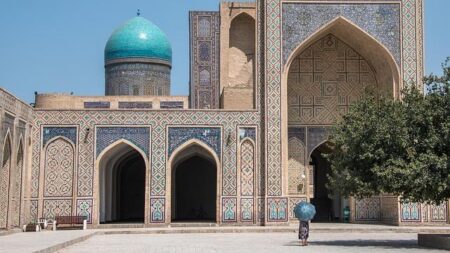Sudan: Examining the Current Civil War and Migration Dynamics
As conflict continues to ravage Sudan, the nation finds itself in the grip of a civil war that has not only destabilized its internal landscape but also forced a staggering number of citizens to flee their homes in search of safety. The conflict, marked by intense clashes between rival factions, has created a humanitarian crisis with far-reaching implications for regional stability and international relations. In this article, we analyze the current situation in Sudan, exploring the roots of the civil war, the plight of displaced populations, and the complex migration dynamics that are emerging as a result. With millions already affected and borders swelling with those seeking refuge, understanding the interplay between conflict and migration in Sudan is more crucial than ever. As we delve into the specifics of this ongoing struggle, we aim to shed light on the broader implications for both Sudan and the international community.
Understanding the Roots of Sudan’s Civil War and Its Impact on Regional Stability
The roots of the current civil war in Sudan can be traced to a complex interplay of historical grievances, ethnic divisions, and political power struggles. Since gaining independence in 1956, Sudan has experienced a series of conflicts fueled by marginalization of various regions, particularly in the Darfur area and the Southern states. Key factors contributing to the violence include:
- Ethnic Tensions: Longstanding rivalries among diverse ethnic groups exacerbated by competition for resources.
- Political Fragmentation: The struggle for power among military factions and political parties has intensified fissures within the state.
- Economic Strain: Declining economic conditions, worsened by climate change, have led to increased desperation and conflict over land and resources.
The ramifications of the civil war extend beyond Sudan’s borders, significantly impacting regional stability in East Africa. Neighboring countries now face a surge in refugee populations, straining their resources and escalating security concerns. According to recent reports, the number of Sudanese fleeing the conflict has reached alarming levels, with millions seeking refuge in countries such as Egypt, Chad, and South Sudan. The repercussions include:
| Host Country | Estimated Refugees (2023) | Key Challenges Faced |
|---|---|---|
| Egypt | 1.5 million | Overcrowding, resource allocation |
| Chad | 400,000 | Limited infrastructure, health services |
| South Sudan | 300,000 | Internal conflict, food insecurity |
As this humanitarian crisis unfolds, the ripple effects of Sudan’s civil war will likely shape political dynamics and stability in the broader region for years to come.
The Humanitarian Crisis: Migration Patterns and Challenges Faced by Refugees
The civil war in Sudan has triggered a profound humanitarian crisis, creating a surge in migration as civilians flee violence and instability. This conflict has been exacerbated by power struggles among various factions and ethnic groups, leading to widespread atrocities and displacement. Reports indicate that millions are now seeking refuge, both within Sudan and in neighboring countries. The primary factors driving this mass migration include:
- Violence and Insecurity: Armed confrontations and lawlessness have made everyday life perilous.
- Economic Collapse: Hyperinflation and lack of basic services have rendered many areas uninhabitable.
- Ethnic Conflicts: Targeted attacks against specific communities have forced individuals to abandon their homes.
As refugees navigate treacherous landscapes in search of safety, they encounter daunting challenges that complicate their plight. Many face limited access to basic necessities, such as food, clean water, and medical care. Bordering nations are often overwhelmed, leading to strained resources and increased competition for aid. The response from the international community remains critical, as many host countries grapple with their own economic struggles, making it difficult to accommodate the influx of refugees. The current situation is underscored by a growing concern for human rights and the need for immediate action to alleviate the suffering of those impacted by the crisis.
Strategic Recommendations for International Intervention and Support in Sudan
In the wake of escalating violence and humanitarian crises in Sudan, it is imperative for the international community to adopt a multifaceted approach to intervention and support. This should include humanitarian aid, diplomatic engagement, and military assistance when necessary. A coordinated effort is essential, involving entities such as the United Nations, the African Union, and regional coalitions to form a comprehensive response. Key recommendations include:
- Enhancing Humanitarian Access: Establishing safe corridors for aid delivery and ensuring protection for humanitarian workers.
- Supporting Regional Actors: Empowering neighboring countries to assist in conflict resolution and to manage refugee influxes.
- Implementing Targeted Sanctions: Applying pressure on key actors who perpetuate violence while ensuring these measures do not exacerbate civilian suffering.
- Promoting Peace Talks: Mediating an inclusive dialogue among opposing factions to find a sustainable resolution to the conflict.
Moreover, addressing migration dynamics is critical as thousands flee the violence, creating potential instability in neighboring nations. Support systems must be established to assist host countries in managing the influx of displaced individuals. This includes:
- Strengthening Asylum Procedures: Enhancing legal frameworks to process asylum requests swiftly and fairly.
- Bolstering Local Integration Programs: Providing resources for education, healthcare, and employment to help integrate migrants into host communities.
- Funding for Refugee Camps: Improving living conditions in refugee camps to reduce the pressure on urban centers.
| Country | Refugee Population | Year-on-Year Change |
|---|---|---|
| Egypt | 250,000 | +15% |
| Chad | 300,000 | +10% |
| South Sudan | 200,000 | +20% |
| Uganda | 500,000 | +5% |
| Central African Republic | 150,000 | +8% |
In conclusion, the international community must act swiftly and decisively to provide multifaceted support to Sudan and its neighbors facing refugee challenges. By enhancing humanitarian efforts, engaging diplomatically, and assisting militarily when required, we can better address the immediate needs and promote long-term stability in the region.
In Summary
In conclusion, the ongoing civil war in Sudan has not only devastated the nation’s social and economic fabric but has also led to a significant displacement crisis, prompting mass migrations both regionally and internationally. As the conflict evolves, the implications for neighboring countries, humanitarian organizations, and global policy discussions grow increasingly complex. Addressing the needs of millions of displaced individuals requires urgent international attention and a coordinated response. As we continue to monitor the situation, the resilience of the Sudanese people amidst such upheaval remains a crucial narrative that underscores the human cost of this conflict. The international community must remain engaged, asking difficult questions and seeking sustainable solutions to not only end the violence but also to address the underlying issues that drive migration and displacement in the region.







